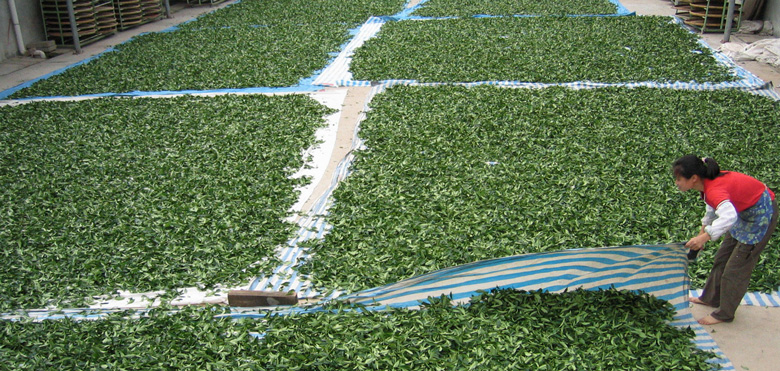What Really is a White Tea?
- Anji Baicha Green Tea 20537 | 8762
- White Peony aka Bai Mudan 白牡丹, This authentic white tea is from Fuding and made in the local style using the Fuding Dabai cultivar, special grade, matured for 1 year. 20197 | 8730
White tea is a label given to those teas that are very lightly “oxidized” (or fermented, as the convention goes) during a long withering process in which the structure of the leaf cell is kept intact and not broken through any external physical interferences, such as curling or twisting. One traditional way of making white tea is to lay the leaves to dry under the sun for the complete process. The white tea will look comparatively duller or darker in colour, the infusion colour warmer and the taste fuller and sweeter.
The reader has to be aware that the names of quite a number of teas from other categories also involve the Chinese character for “white”. One immediate example is the famous Anji Bai Pian (White Pieces from Anji; in recent years it is also called Anji Bai Cha — White Tea from Anji), an exquisite green tea. Milan Xiang, a popular Phoenix Oolong, has another name, “Bai Ye” (White Leaf). It has been a long tradition in rural China to call lighter colour leaves as “white”. These teas, however, are not white teas.
We have included Shengcha Puers and the likes in this category, since they are made pretty much in the same way as White Teas are made. Similar biochemical changes take place during the process so they fit in perfectly. The only difference is: the use of totally different cultivars, and some twisting done onto the leaves prior to drying.
Yellow teas are also lightly oxidized teas, but their production is very different and will be discussed separately.
origin
The process of sun-drying tealeaves should have been one of the most ancient ways of processing tea. It is still practiced in Yunnan and a few mountain tribes south and southwest of the province, in neighbouring countries. Piling the leaves in a heap somewhere in the process and let fermentation happen should have begun in a somewhat accidental manner.
However, it was in the northern part of Fujian that tea producers first systematically made use of that accident to have employed more downy tea buds to make a different tea. At around 1780, a “Pekoe Tea” gained attention in the county of Jianyang. It was almost an instant hit (maybe due to a lower price than other fine-looking tea) that the making method soon spread to neighbouring counties. In 1857, people in the county of Fuding transplanted a large leaf variety from the mountains in Taimu to make the first modern version of Silver Needles. Fuding Dai Bai (the Large White Leaf of Fuding) later became a most important production cultivar for green, black and post-fermented teas for the whole country. A couple of decades later, 140 km west, the county of Zhenghe came up with their own cultivar, Zhenghe Dai Bai.
Zhenghe and Fuding remain today the two key fine White tea production areas, and the two cultivars are still the key production plants.

Tealeaves being sunned during white tea processing in Fuding, Fujian. This is a batch for White Peony.
production
Traditionally, first flushes are sunned on flat bamboo sieves and then wither for 3 days in the shade before drying and finishing. Unstable weather in Spring had caused much fluctuation in productivity and destroyed harvests. Most producers now heat their withering chambers to around 32°C to maintain full capacity in spite of weather.
Compared to the traditional process, the tea dries much faster in a heated situation. Lesser fermentation/oxidation takes place because there is less time. To compensate for that, the withering tea is further piled up during the process for a couple of hours to let the biological heat within trigger the enzyme oxidation that is required to result in the particular chemical composition of White tea. Skillful hands are required for that since it is important not to physically break the leaf cells during the handling. Pile temperature control is another key such that the tea would not turn into a bad yellow or black tea, or worst yet, a pile of stinky leaves. The tea master, like those in oolong tea making, has to watch for the thickness and the duration of the piling by experience and checking of the gradually intensifying aroma.
unique taste and health characters
Whether traditional process of prolonged withering in the shade or piling up a few inches in a warmed chamber, it is this oxidative / fermentation change that gives white teas their unique biochemistry to make them different from other teas in taste and health contributing characters.
It is also this chemistry that make true white teas mature-able. This is unlike short-fermentation black teas, green teas or any other teas that are falsely labelled as white.
There are two main types of White teas: White Peony (Bai Mu Dan) and Silver Needles (Bai Hao Yin Zhen). There are now variations of these and called by various names, but are basically similar products from different locations, plant varieties, or sheer marketing gimmicks.
tasting notes
Unlike green teas, white teas should be infused at a higher temperature, between 90~100°C, in order for the aroma, sweetness and depth to fully infuse into the liquor. For preparing Silver Needles, those who prefer stronger taste may consider putting in a bit more tealeaves.














😉
I was reading “Obscurantism: What Tea are you Really Buying?” and jumped to this article, so I was a bit confused seeing “oxidized” and fermented as beeing the same.
Thanks to clarify it!
I have a question, sometimes you refer to oxidation and fermentation as beeing the same but I think that they are different process. During fermentation there are live micro-organisms acting in the tea, while during oxidation only oxygen reacts with the flavonoids.
Thanks!
That is why we have put the quotation marks around “fermentation”. If you read more of our articles, you’ll understand that we are in agreement with your point. It is just that so many in the tea trade have used the term fermentation extensively for the process of oxidation that we have to use it lest many readers won’t understand what it is. In reality, the process is a lot more complicated than simply oxidation or fermentation. The Chinese term “Zao Qing” is actually a bit more embracing to the complex bio activities during the course.